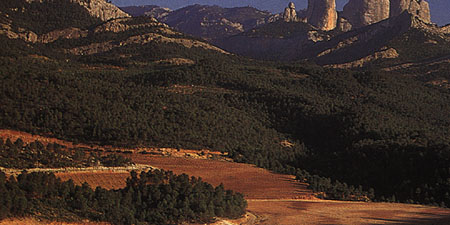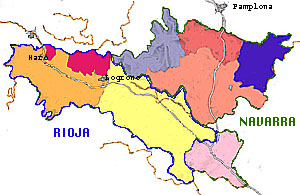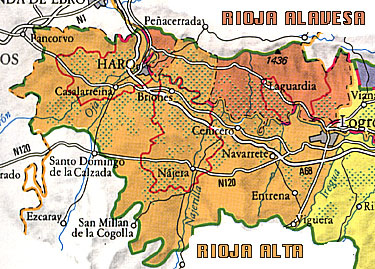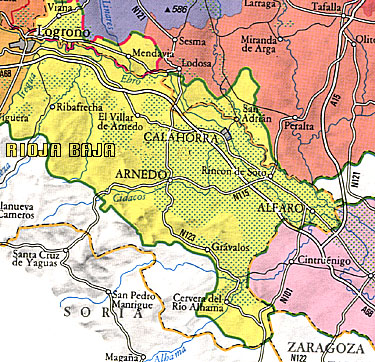
WineRegionsOld WorldSpain

Sans-Chene, traditional, red wine
Oak cask-aging is of prime importance to the character of Rioja's wines.
You cannot visit the region without encountering Bordeaux sized, 225 litre
barriques by the thousand. Some bodegas, however, seem to go to extraordinary
lengths to remove all trace of the oak's influence. They steam-clean the
aldehydes, mostly vanillin, from the wood and then use the barrels to store
lesser wines before using them for Reservas and Gran Reservas Only a very
few Riojas made in this way have sufficient character to be successful.
Such wines derive extra concentration from lower yields, but they are not
Rioja in the classic sense. The region has justly achieved world-wide fame
for its ability to produce fine quality red wines that are distinctly oaky
and competitively priced.
Riojas "new-wave" whites
The story for whites is a little different, because, given the equivalent
oak-aging of a Rioja tinto, a Rioja bianco loses its fruit and freshness,
rapidly oxidizes and leaves a sharp, acid taste in the mouth. Unlike the
sans-chene reds, the ultra-clean "new-wave" whites deserve a place
in today's market, where trends are for lighter, fresher and drier wines.
It is interesting to note that, starting with the 1978 vintage, even Marques
de Murrieta bianco, perhaps the most traditional of white Riojas, began
to change its spots: first a touch of fruit, then some freshness, and now
a modest balance of both. Much white wine is still made in the traditional
style, but virtually every major exporting house at least offers an alternative,
in the form of "new-wave" white wine. Headed by the Marques de
Caceres bianco, a steely-crisp and clean wine that can be reminiscent of
Sauvignon blanc, although made from 100 per cent Viura grapes, this category
is firmly established with consumers. Whereas these wines are enjoyable,
they do not, as yet, possess any distinctive generic characteristics that
identify them as Rioja. The whites that manage to combine the best of the
old and the new have more distinct regional characteristics. Olarra's "snares
Blanco Seco" Franco-Espanolas' "Diamante" and CVNE's "Monopole",
for example, manage to combine the creamy-vanilla oak character that is
the hallmark of Rioja, with superb freshness and heaps of creamy lemony
fruit.

RIOJA'S DISTRICTS
Rioja's 37,500 hectares (92,665 acres) of vineyards are located along the
Ebro Valley, between Haro and Alfaro, and throughout its hinterland, with
vines clustered around many of the Ebro's tributaries, one of which, the
Oja River gave its name to the region. An average of 12 million cases (
1,080,000 hectolitres) of wine is produced every year, some 70 per cent
of which is red, 15 per cent white and 15 per cent rose, called rosado Most
Rioja is blended from wines or grapes originating from the region's three
districts: Rioja Alta, Rioja Alavesa and Rioja Baja.

Rioja Alta
Vineyards: 16,130 hectares (39,860 acres)
Grape varieties: Tempranillo 60%, Mazuelo 10%, Garnacha 10%, Graciano 2%,
Viura 15%, Malvasia 2%, Others 1%
The principal towns of Rioja, Logrono and Haro, are both in the Rioja Alta.
Logrono is a very big town bv Spanish standards, but Haro, at the western
edge of the region, is a much smaller, far more charming, older and traditional
enclosed hilltop community The area's wine is Rioja's fullest in terms of
fruit and concentration, which can be velvety smooth. Bodegas Muga makes
fine examples of pure Rioja Alta, as do CVNE ("Imperial").
Rioja Alavesa
Vineyards: 8,035 hectares (19,855 acres)
Grape varieties: Tempranillo 80%, Garnacha 5%, Viura 10%, Others 5%
There are no large towns in the Alavesa, a district that is similar in climate
to the Alta. The wines produced here are Rioja's fullest in body and reveal
a much firmer character than those of the Alta and Baja, with greater acidity.
It was to the Alavesa that Pedro Domecq came, after years of intensive research,
to plant a vast estate of 400 hectares (985 acres), cultivating his vines
on wires as opposed to using the bush method traditional to the region.
Apart from Domecq Domaine, which is obviously a pure Alavesa wine, Remelluri's
"Labista de Alava" and Laserna's "Vinedos del Contino, two
single-vineyard Alavesas, and CVNE's Real range (although not quite 100
per cent Alavesa), are all typical of the district.

Rioja Baja
Vineyards: 13,335 hectares (32,950 acres)
Grape varieties: Tempranillo 2%, Garnacha 90%, Viura 3%, Others 5%
A semi-arid area influenced by the Mediterranean, it is hotter, sunnier
and drier than the Alta and Alavesa, with rainfall that varies throughout
the region, averaging between 38 and 43 centimetres (15 and 17 inches) per
year, but falling es low es 25 centimetres (10 inches) at Alfaro in the
south. Some 20 per cent of the vines growing in Rioja Baja come within,
and can claim, the Navarra appellation. The wines are deep-colored and very
alcoholic, sometimes as strong as 18 per cent, but lack acidity, aroma and
finesse, and are best used for blending.
Rioja
Navarra
Penedes